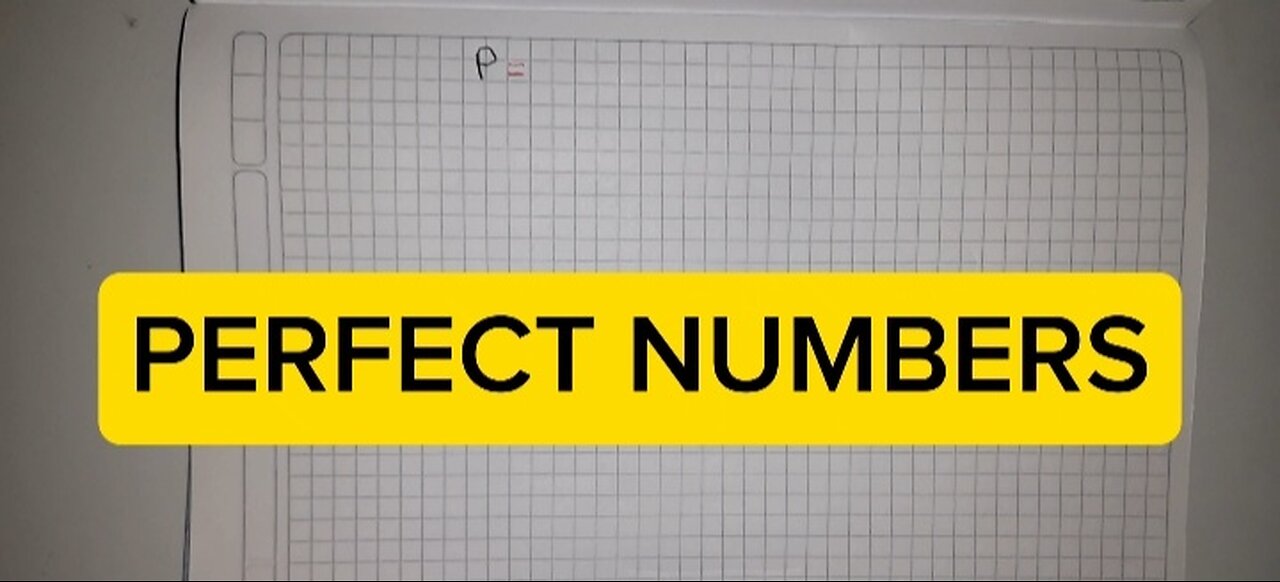Premium Only Content

Euclid-Euler theorem: Perfect numbers
The Euclid-Euler theorem is a fundamental theorem in number theory that establishes a relationship between Euler's phi function and the prime factorization of an integer.
Statement of the theorem
If n is a positive integer and p1, p2, ..., pk are the distinct prime factors of n, then:
φ(n) = n * (1 - 1/p1) * (1 - 1/p2) * ... * (1 - 1/pk)
where φ(n) is the Euler phi function, which counts the number of positive integers less than or equal to n that are relatively prime to n.
Proof of the theorem
The proof of the Euclid-Euler theorem is based on the following idea:
1. If p is a prime factor of n, then the number of positive integers less than or equal to n that are divisible by p is n/p.
2. The number of positive integers less than or equal to n that are relatively prime with n is equal to the total number of positive integers less than or equal to n minus the number of positive integers less than or equal to n that are divisible by some prime factor of n.
3. Using inclusion-exclusion, we can calculate the number of positive integers less than or equal to n that are relatively prime to n.
Consequences of the theorem
The Euclid-Euler theorem has several important consequences in number theory, such as:
1. Euler's phi function is multiplicative, that is, if m and n are coprime positive integers, then φ(mn) = φ(m)φ(n).
2. Euler's phi function is a fundamental tool for studying the structure of cyclic groups and rings of modular integers.
3. The Euclid-Euler theorem is used in the proof of the Fermat-Euler theorem, which states that if p is a prime number and a is a positive integer coprime with p, then a^(p-1) ≡ 1 (mod p).
Applications of the theorem
The Euclid-Euler theorem has several important applications in cryptography, number theory and computing, such as:
1. RSA Cryptography: The Euclid-Euler theorem is used in proving the security of the RSA algorithm.
2. Euclid's Algorithm: The Euclid-Euler theorem is used in proving the correctness of Euclid's algorithm to calculate the greatest common divisor of two integers.
3. Modular Computation: The Euclid-Euler theorem is used in modular computing to compute the Euler phi function and perform modular operations efficiently.
Perfect numbers are positive integers that are equal to the sum of their proper divisors, excluding the number itself. In other words, a perfect number is a number that is equal to the sum of its proper divisors, not including the perfect number itself.
Examples of perfect numbers
1. 6: 1 + 2 + 3 = 6
2. 28: 1 + 2 + 4 + 7 + 14 = 28
3. 496: 1 + 2 + 4 + 8 + 16 + 31 + 62 + 124 + 248 = 496
Properties of perfect numbers
1. _Parity_: All perfect numbers are even.
2. _Prime factorization_: All perfect numbers have a unique prime factorization.
3. _Relationship with prime numbers_: Perfect numbers are related to prime numbers, since the sum of the proper divisors of a perfect number is equal to the perfect number itself.
Perfect number theory
The theory of perfect numbers dates back to ancient Greece, where perfect numbers were believed to have special properties. Throughout history, many mathematicians have studied perfect numbers, including Euclid, Euler, and Gauss.
Open problems in the theory of perfect numbers
1. _Infinity of perfect numbers_: It is unknown if there are an infinite number of perfect numbers.
2. _Distribution of perfect numbers_: It is unknown how the perfect numbers are distributed on the number line.
3. _Relationship with other mathematical concepts_: It is unknown if there is a deep relationship between perfect numbers and other mathematical concepts, such as prime numbers or algebraic integers.
Applications of perfect numbers
Perfect numbers have applications in several areas, including:
1. _Cryptography_: Perfect numbers are used in cryptography to build secure encryption algorithms.
2. _Number theory_: Perfect numbers are used in number theory to study the properties of integers.
3. _Recreational mathematics_: Perfect numbers are used in recreational mathematics to create interesting problems and games.
-
 11:52
11:52
Dr. Nick Zyrowski
9 hours agoWhat Can I Eat On The Carnivore Diet? | Detailed Guide
8972 -
 16:23
16:23
TSPLY
18 hours agoNew CNN / MSNBC Meltdown Moments Of Getting Mad At Donald Trump And Elon Musk
6013 -
 30:54
30:54
Cooking with Gruel
17 hours agoCooking with Matt and Ginger Gaetz
1.21K2 -
 1:22:55
1:22:55
MTNTOUGH Fitness Lab
19 hours agoHomeland Security Pulls Us Off The Plane! Jaw-Dropping Moments from MTNTOUGH's 2024 Ibex Hunt
1.42K1 -
 1:05:30
1:05:30
Kyle Rittenhouse Presents: Tactically Inappropriate
13 hours agoHey Doge, Where's My Coin?
1.39K2 -
 4:44
4:44
America First Policy Institute
21 hours agoAmerica First Unfiltered: Trump’s Historic First Month – Real Wins for Real Americans! 🇺🇸 #news
1.41K1 -
 8:22
8:22
DropItLikeItsScott
1 day agoThis IS one of the Greatest AR's EVER! The Nemesis by Special Ops Tactical
1.46K1 -
 2:42:30
2:42:30
TimcastIRL
11 hours agoKash Patel CONFIRMED, Deep State PANICS, Mitch McConnell To RETIRE w/ Kevin Smith | Timcast IRL
186K354 -
 1:04:47
1:04:47
Candace Show Podcast
15 hours agoBecoming Brigitte: The Epilogue
131K174 -
 3:43:51
3:43:51
Alex Zedra
10 hours agoLIVE! Come Play WoT with me!
53.2K12